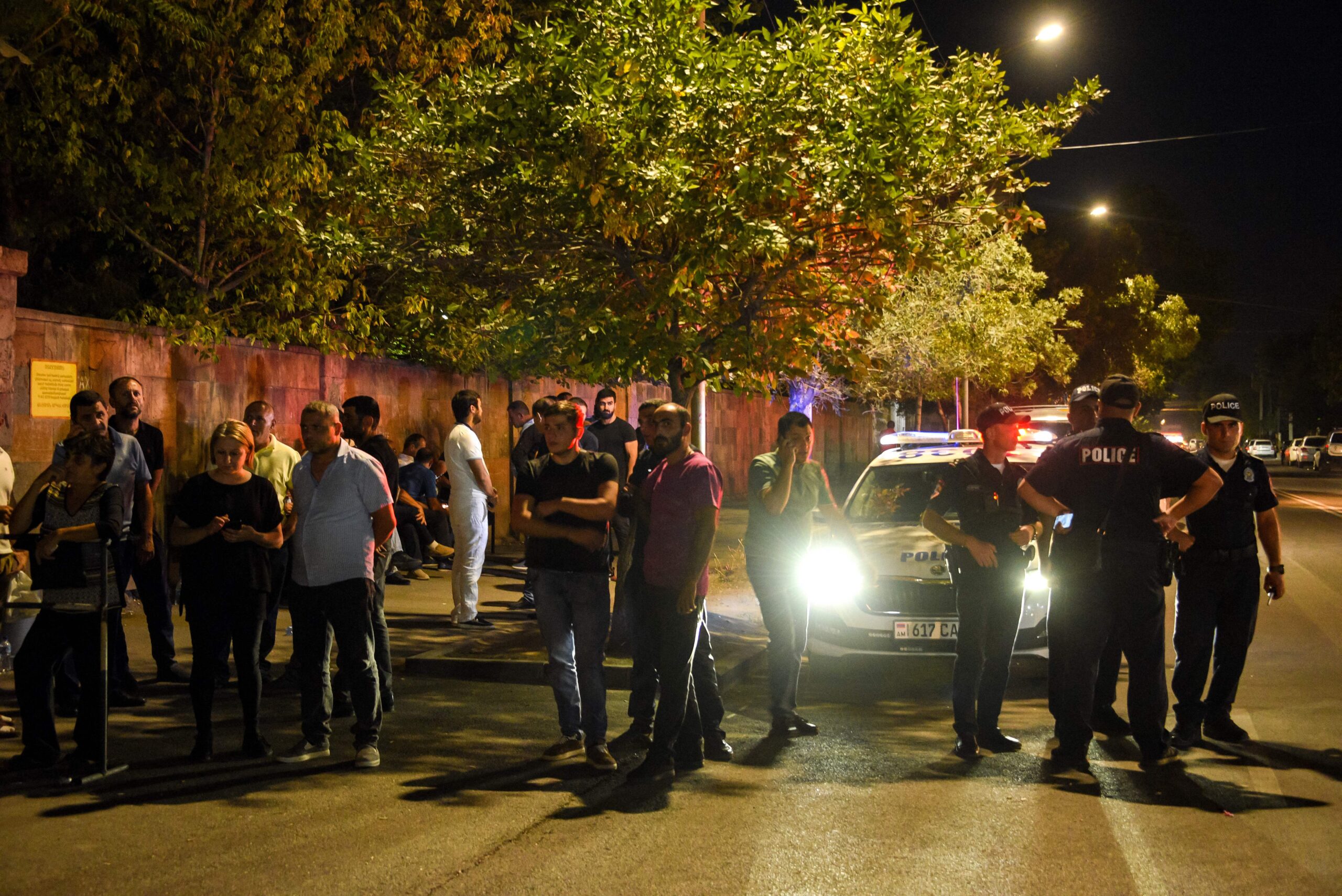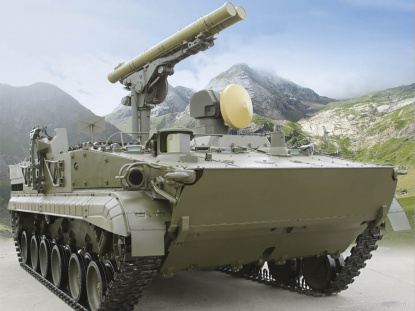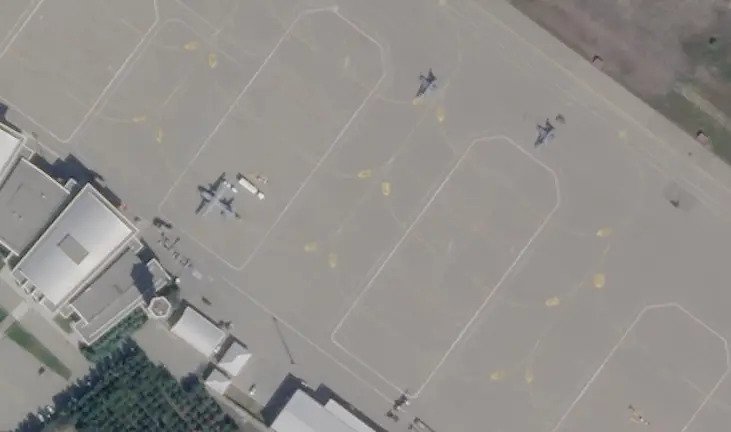The long-standing conflict between neighboring former Soviet Republics Armenia and Azerbaijan blew up early Tuesday, with Armenia claiming 49 of its troops were killed, Azerbaijan claiming 50 of its troops killed, and each side blaming the other for sparking this latest round of bloodshed.
Armenia said that shortly after midnight Tuesday local time, it was attacked by Azerbaijani forces using “artillery, mortars, drones and large-caliber rifles in the directions of Vardenis, Sotk, Artanish, Ishkhanasar, Goris and Kapan, targeting both military and civilian infrastructures.”
Azerbaijani officials said its military was responding to Armenian mine-laying operations and ongoing shelling.
The Russian Foreign Ministry said a ceasefire was agreed to at 9 a.m. Moscow time.
Though the situation remained tense as of Tuesday evening local time, both sides said the initial burst of kinetic action had subsided.
As of 2 p.m. local time Tuesday, “the situation in some parts of the Armenian-Azerbaijani border continues to be extremely tense,” the Armenian Defense Ministry said Tuesday. “Despite the significant reduction in the intensity of the shelling, the enemy continues attempting positional advancement, particularly in the direction of Nerkin Hand, Verin Shorzha, Artanish and Sotk. The units of the Armed Forces of the Republic of Armenia continue to complete the combat tasks set before them.”
“The provocations committed by the Armenian armed forces on the border of the two states were prevented, and all relevant duties and tasks were fulfilled,” the Azerbaijani Ministry of Defense said in a statement Tuesday.
The incident, the worst fighting between the two since a 2020 war that killed thousands of troops and civilians, comes at a fraught time, with a very hot war between Russia and Ukraine waged some 600 miles to the northwest.
Because of the region’s location, and the religious makeup of the combatants – Armenia is a majority Christian nation while Azerbaijan is a majority Muslim nation – clashes between the two well-armed nations generate global concerns.
The two countries fall within the spheres of influence of Russia, Turkey and Iran and have each amassed arsenals of modern weaponry supplied by those nations, as well as the U.S. and Isreal, among others.

Here are some of the additional details we know about the latest flare-up and its potential impact on the region and the world.
Armenian Prime Minister Nikol Pashinyan told his nation’s National Assembly on Tuesday that “the armed forces of Azerbaijan took offensive actions in the direction of the Republic of Armenia. Azerbaijan tries to present that these actions were in response to the provocations of the Armenian side. We must unequivocally record that this information is absolutely false, a lie and does not correspond to reality.”
“As of now, we have 49 victims confirmed by the Ministry of Defense,” he added. “And as long as there are such people who are ready to put their lives in danger at a decisive moment, even to sacrifice for the sake of the motherland, it means that the Republic of Armenia has and will have sovereignty, the Armenian statehood will be permanent, and the people of Armenia will be able to be proud of their children.”
As of the time of Pashinyan’s statements, “the intensity of combat operations has decreased, but the offensive operations of Azerbaijan continue in one or two directions. The RA Ministry of Defense [and] the General Staff are assessing the situation, the losses, and the adjusted information will be published officially.”

In the wake of this latest incident, Armenia appealed to the Russian-led Collective Security Treaty Organisation (CSTO) and also reached out to Moscow, as well as several other nations, including “the President of France, the President of the Republic of Iran, the U.S. Secretary of State, and the President of the Council of the European Union.”
“The Minister of Defense had a conversation with his Russian counterpart, and work is being done in these directions to stabilize the situation as quickly as possible,” Pashinyan added.
Azerbaijan, however, said its attack was designed to halt Armenian forces from planting land mines and that “the Armenian side’s regular shelling of Azerbaijan Army positions is to delay the signing of a peace treaty, as well as large-scale restoration and construction work carried out in the liberated territories.”
“By laying mines in Azerbaijani territories and on the supply roads, the opposing side demonstrates behavior contrary to the statement,” Chief of the International Military Cooperation Department of the Ministry of Defense, Major General Huseyn Mahmudov, said Tuesday at a briefing of foreign military attaches. “This is evidence confirming Armenia’s military adventurism and revanchist position.”
During the night of September 12, “the Armenian armed forces units committed large-scale provocations in the Dashkasan, Kalbajar and Lachin directions of the Azerbaijani-Armenian state border,” the Azerbaijanian Ministry of Defense (MOD) said in a statement.
“At night, the sabotage groups of the Armenian armed forces using the mountainous terrain of the area and the existing ravine gaps mined the territories and supply roads between the positions of the Azerbaijan Army Units in different directions.”

The confrontation was the result of “urgent measures taken by the Azerbaijan Army Units in order to immediately suppress these actions. The Armenian armed forces stationed in the directions of Basarkechar, Istisu, Garakilsa and Gorus settlements using various caliber weapons and mortars subjected to intensive fire some positions, shelters and strongholds of the Azerbaijan Army in the territory of Dashkasan, Kalbajar and Lachin regions.”
As a result, “there were losses among the military personnel, the military infrastructure was damaged,” the Azerbaijanian MOD said, adding that at least 50 of its troops were killed. “The Azerbaijan Army Units deployed in these directions are taking decisive retaliatory measures in order to suppress provocations committed by the Armenian armed forces and military threats to the territory and sovereignty of Azerbaijan, to ensure the safety of the military personnel, including civilian workers involved in infrastructure work in the territory of Kalbajar and Lachin regions.

What’s It All About?
The crux of this conflict is the mountainous enclave of Nagorno-Karabakh, which is located inside the borders of Azerbaijan and is internationally recognized as Azerbaijani territory. However, its population of about 150,000 are mostly ethnic Armenians who see themselves “as a de facto independent republic, with its own parliament, president and army,” according to the Lawfare blog.
Over the years, the enclave has been referred to variously as the Nagorno-Karabakh Region (NKR) or the Republic of Artsakh.
The conflict “extends beyond an internal fight between Azerbaijan and a breakaway republic. Armenia does not claim ownership of Nagorno-Karabakh but considers itself the guarantor of the security of the ethnic Armenians living in the region and is NKR’s lifeline to the outside world,” according to the Lawfare blog.
Enmity over this enclave began after the Russian Revolution in 1917 and continues to this day. When the Soviet Union took control of the Caucuses, “Nagorno-Karabakh was ultimately placed within the boundaries of Soviet Azerbaijan — though it was granted autonomous status as the Nagorno-Karabakh Autonomous Oblast (NKAO). The oblast’s borders were drawn such that they were not contiguous with the Armenian Soviet Socialist Republic (SSR),” the Lawfare blog states.
“During Mikhail Gorbachev’s era of perestroika and glasnost toward the end of the Cold War in the late 1980s, the regional government once again demanded a transfer to Armenia, passing a resolution in its representative body in 1988.”
But despite the USSR’s policy of increased democratic openness, “the response from the Azerbaijani authorities was heavy-handed. In February 1988, the Sumgait massacre saw hundreds of Armenian civilians indiscriminately killed, raped, maimed and burned alive. In 1990, the Baku pogrom resulted in the beating, killing, and otherwise expulsion of all Armenians from Azerbaijan’s capital city,” Lawfare states.
Ethnic Armenians declared the region to be an independent state in 1991 amid the collapse of the Soviet Union. This led to an all-out war between Armenia and Azerbaijan.
Though a ceasefire deal came into effect in 1994, there have been major outbreaks of fighting, as well as persistent low-level skirmishing, since then. There were relatively large clashes in 2016, a worrisome burst of violence in July of 2020 and a full-scale war that November.
You can read more about our coverage of that conflict here.
Regional Conflict, Global Concerns
Russia considers the region, located in the Southern Caucuses, as its “near abroad,” brokering cease-fires each time the conflict escalates but also selling arms to both sides.
Iran, on the border of both nations, considers the region an area of interest as well.
Tuesday, Iranian Foreign Ministry Spokesman Nasser Kanaani said that Iran will not accept any changes in the borders of the Republic of Azerbaijan and the Republic of Armenia.
And Turkey, which borders Armenia, said on Tuesday it continued to back Azerbaijan and called on Armenia to “cease its provocations” after clashes erupted between the two South Caucasus countries that resumed decades-old hostilities, according to Reuters.
Turkish Defence Minister Hulusi Akar held talks with Azeri counterpart Zakir Hasanov, the ministry said. “He emphasized that Turkey has always stood by brotherly Azerbaijan and will continue to stand by it in its just causes,” it said.
There is growing concern that Russia, which has been suffering large-scale defeats in Ukraine, might use this conflict to deflect attention.
“Whether Russia tries in some fashion to stir the pot, to create a distraction from Ukraine, is something we’re always concerned about,” Blinken told reporters at an event in Indiana, according to Reuters. He added that Russia could also use its influence in the region to help “calm the waters.” That appears to be the case based on the brokered ceasefire, but it is still just hours old.
Huge Arms Market
Last year, the Stockholm International Peace Research Institute (SIPRI) examined arms supplies to both sides during the November 2020 conflict.
“SIPRI estimates that over the decade 2011–20 Russia was the largest exporter of major arms to both Armenia and Azerbaijan. It supplied nearly all of Armenia’s major arms during the period and almost two-thirds of Azerbaijan’s. Israel, Belarus and Turkey were, respectively, the second, third and fourth largest suppliers of major arms to Azerbaijan in 2011–20.”

Despite Russia “acting as a leading mediator in the conflict between the two countries, in 2011–20, it accounted for 94 percent of Armenia’s imports of major arms and 60 percent of Azerbaijan’s,” SIPRI reported.
“The Russians provided Armenia with armored personnel carriers, air defense systems and multiple rocket launchers and tanks — all of which were used in the 2020 war. Russia’s supplies to Azerbaijan included armored vehicles, air defense systems, transport and combat helicopters, artillery, multiple rocket launchers and tanks. All of these weapon types were used during the 2020 war over Nagorno-Karabakh.”
Israel accounted for 27 percent of Azerbaijan’s imports of major arms between 2011 and 2020.
“Most of these deliveries took place in 2016–20,” SIPRI reported. “While there is sufficient information available publicly to determine the types of weapons supplied by Israel to Azerbaijan, little is known about the actual number of arms transferred. Of the major arms supplied by Israel, loitering munitions, reconnaissance unmanned aerial vehicles (UAVs), guided missiles and ballistic missiles were known to have been used in the 2020 war with Armenia as well as during some of the earlier border skirmishes.”

The weapons tracking group Oryxspioenkop.com’s website offers a detailed breakdown of Israeli arms shipments to Azerbaijan here. Of them, probably the most high-profile has been the loitering munitions which had a devastating impact, both physically and mentally, during the 2020 war.

SIPRI estimates that arms exports to Azerbaijan accounted for 17 percent of Israel’s total exports of major arms in 2016–20, showing the growing importance of Azerbaijan to the Israeli arms industry.
“In 2016 President Aliyev stated that Azerbaijan had spent $5 billion on military equipment from Israel. There is some speculation as to whether economic revenue is the primary driver for Israel’s ongoing arms transfers to Azerbaijan or if there are other major motives, such as Israel’s dependence on oil from Azerbaijan or a shared threat perception towards Iran.”
Between 2011 and 2021, Belarus accounted for 7.1 percent of Azerbaijan’s major arms imports. It supplied a few ground attack aircraft, air defense systems, tanks, artillery, and guided rockets.
“Such arms supplies have become an important part of the relations between the two countries, not in the least due to Belarus’s growing demand for Azerbaijani oil in an attempt to become less dependent on Russian oil,” SIPRI reported.
The two countries also cooperate in combat training and operational planning; further military and technical cooperation may have included the supply of military equipment or repair and maintenance services for such equipment.
Turkey accounted for 2.9 percent of Azerbaijan’s imports of major arms over the decade 2011–20. Deliveries from Turkey to Azerbaijan in this period included armored patrol vehicles, rocket artillery, missiles, and armed UAVs.
“The armed UAVs, which were delivered shortly before the 2020 war, included at least five Bayraktar-TB2 UAVs armed with MAM-L guided bombs,” according to SIPRI. “The use of these UAVs during the war received significant international attention. While it is unclear whether and how Azerbaijan used other major arms supplied by Turkey in the 2020 war, some reports do suggest their involvement. For example, Turkish-supplied TRG-300 multiple rocket launchers were reported to be located in positions of strategic importance for Azerbaijan’s offensive in Nagorno-Karabakh in 2020.”
Turkey’s arms transfers to Azerbaijan “seem to be linked not only to the strong economic ties and cultural links between the two countries but also to Turkey’s broader foreign policy interests. Through strengthening relations with Azerbaijan, Turkey also appears to be expanding its political presence in the South Caucasus—notably in competition with Russia, currently the dominant power in the region.”
In October 2020, The War Zone reported that satellite imagery showed F-16 Viper fighter jets belonging to the Turkish Air Force at Ganja International Airport in Azerbaijan. This is the first hard evidence that at least some of these jets were in that country after fighting erupted between it and its neighbor Armenia over the long-disputed Nagorno-Karabakh region.

You can read more about that here.
The U.S., by comparison, sold both sides “nearly equal amounts of military equipment,” according to the Armenian EVN News Foundation.
“According to the latest data, made public in the 2020 Historical Sales Book, published by the Defense Security Cooperation Agency (DSCA) of the U.S. Department of Defense, the U.S. has sold nearly equal amounts of military equipment to Armenia and Azerbaijan. The data indicates that Armenia has received $51.1 million in military sales, with Azerbaijan at $56.2 million.”
Though calm seems to have been largely restored, tensions are always simmering and we will keep a close watch on further developments.
Contact the author: howard@thewarzone.com
